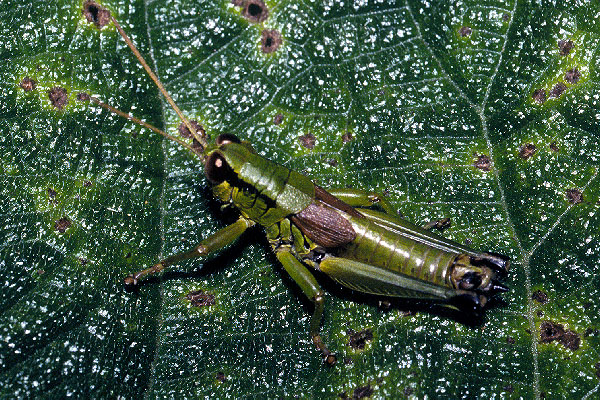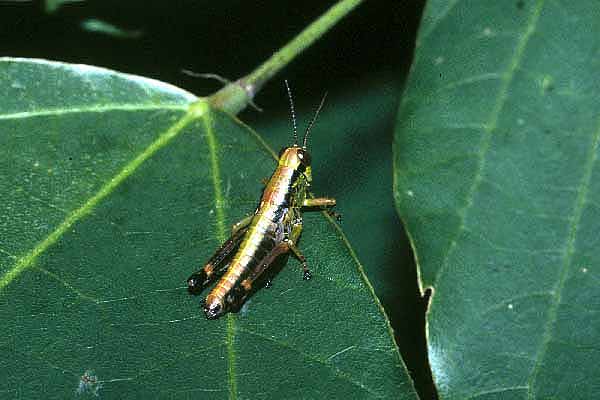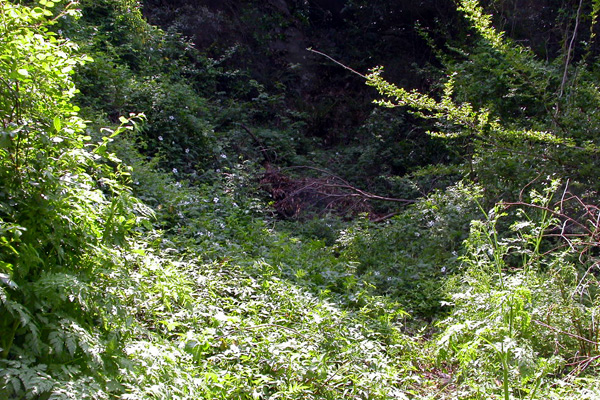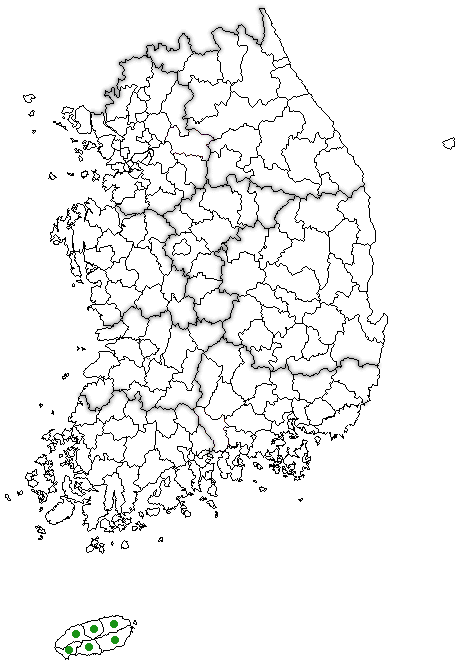제주밑들이메뚜기
[=반디밑들이메뚜기]
Parapodisma setouchiensis Inoue
1979
=Parapodisma bandii An
and Lee 1986
몸길이는 약 24-38 ㎜이며 녹색이다. 한국산 밑들이메뚜기 중에서 앞가슴등판의 길이가 길고 적색의 앞날개가 잘 발달한 편이다. 일본에도 분포한다.

수컷
(Male)

유충
(Larva)

서식처
(Habitat)
Original description: Parapodisma setouchiensis Inoue 1979
♂. Body
of average size, comparatively stout. Head and pronotum yellowish
green or olive-green, with a pair of blackish lateral stripes from
behind eye to anterior part of pronotum. Frons pale yellowish green.
Antennae pale brown. Eyes brown or reddish brown. Tegmina pale brown.
Wings light brown. Tergites pale greenish brown. Anterior and middle
legs pale yellowish green. Hind legs with femora which are dark
olive-green dorsally and pinkish ventrally, black genicules and
pale bluish green tibiae with black spines. Subgenital plate black
in greater part. Mesosternum and metasternum pale bluish brown or
yellowish brown. Abdomen pale yellowish brown ventrally.
Head
short, about 0.6 times as long as pronotum. Frontal ridge furnished
with a wide and shallow grrove at middle, parallel-sided or slightly
constricted at fastigium and beneath the median ocellus. Vertex
slightly depressed. Fastigium provided with a longitudinal median
groove which is narrow and shallow. Width of vertex between eyes
a little less than the width of frontal ridge between antennae.
Eyes large, oval, of vertical diameter 1.3 times as long as horizontal
diameter and 1.7 times as long as subocular groove. Antennae thin,
22 to 24-jointed, 1.3 times as long as head and pronotum together.
Pronotum subcylindrical, with 3 transverse grooves, of which 2 anterior
grooves are somewhat narrow and shallow and sometimes faint near
the middle and with a median longitudinal carina which is indistinct
in prozona and distinct in metazona; prozona finely and sparsely
punctate, comparatively short, about 1.4 times as long as metazona;
metazona slightly flattened, densely punctate, with the posterior
margin which is slightly angulate at middle; lateral carina absent.
Tegmina comparatively large, elliptical, about 2.1 times as long
as wide, overlapped each other on dorsal surface, narrowly rounded
at apex, usually reaching the posterior margin of the 3rd tergite.
Wings comparatively large, about 0.8 times as long as tegmina. Hind
femora slender, long, about 4.2 times as long as width, the dorsal
carina smooth, each with a distinctly pointed apical spine. Hind
tibia each with 9 to 11 marginal spines. Last abdominal tergite
medially split, without lobules (furculae). Prosternal process conical,
pointed at apex. Mesosternal lobes slightly transverse, the interlobar
space slightly compressed medially, as long as or slightly longer
than wide. Metasternum wide, with the interlobar space which is
longitudinal, slightly narrower than the width of frontal ridge,
and strongly compressed in posterior part.
Supra-anal
plate nearly triangular, with a wide, shallow median groove which
is medianly constricted, and with two pairs of small tubercles on
the lateral margins near base and apex. Cerci elongate-triangular,
about two times as long as its greatest width, wide at base, apically
convergent in the basal one-half to two-thirds and then not or slightly
divergent, with apices which are slightly compressed, distinctly
angulated below and sometimes curved inwards, and are nearly as
long as supra-anal plate. Subgenital plate rather long, about 0.4
times as long as pronotum, with an elongate process which is prolonged
from apex towards base in the dorsal edge. Anterior edge of epiphallus
almost straight between ancorae, lophi oblique, like a plate. Apical
lobes of penis long and sigmoid.
♀. Body larger
than male. Width of vertex between eyes as wide as or slightly wider
than frontal ridge between antennae. Vertical diameter of eyes about
1.4 times as long as horizontal diameter and 1.5 times as long as
subocular groove. Antennae almost as long as head and pronotum together.
Pronotum slightly and gradually widened towards posterior margin.
Tegmina smaller than in male, about two times as long as wide, overlapped
or slightly separated from each other on dorsal surface, usually
reaching the middle of third tergite. Hind tibia with 9-12 outer
spines, and 10-12 inner spines. Mesosternal lobes transverse, wider
than in male, the interlobar space nearly rectangular or slightly
transverse. Metasternum wider than in male, the interlobar space
broader than the frontal ridge.
Supra-anal plate
elongated triangular, with a longitudinal median depression at base
and a very slightly arcuate transverse groove a little anterior
to the middle. Cerci conical, laterally compressed, straight, pointed
at apices, not reaching the apex of supra-anal plate, 1.3 times
as long as its greatest width. Subgenital plate elongated, with
a distinct triangular tubercle in the posterior edge, 0.5 times
as long as pronotum. Ovipositor valve short, straight, with a pointed
apex, irregularly serrate along the outer dorsal edge.
Measurements
in milimeter (20 examples in both sexes). Body length, ♂ 24.9-28.0
(26.3 in average), ♀ 32.4-38.0 (35.4); antennal length, ♂ 11.0-14.5
(12.8), ♀ 11.8-14.2 (13.0); pronotal length, ♂ 6.7-7.1 (6.5),
♀ 7.9-8.8 (8.3); tegminal length, ♂ 7.6-9.0 (8.0), ♀ 8.8-10.9
(9.7); hind femoral length, ♂ 13.4-15.2 (14.4), ♀ 16.5-19.2 (18.2).
Type
series. Holotype: ♂, allotype: ♀, paratypes: 20♂♂, 20♀♀, Ichi
(200 m alt.), Mitsugi-cho, Mitsugi-gun, Hiroshima Prefecture, VIII-3
1974, M. Inoue leg.
The holotype, allotype and several
paratypes are preserved in the collection of Entomological Laboratory,
College of Agriculture, Ehime University, and the remaining specimens
are put in my collection.
Distribution. Sanyo district
of Honshu and northern half of Shikoku district, Japan.
Notes.
This new species resembles P. dairisama
in the general appearance, but the former differs from the latter
in the shape and size of tegmina, cerci, and of subgenitaln plates.
Although closely related also to another new species,
P. niihamensis n. sp. described later,
it may be identified by the differences stated in the description.

<참고문헌>
● An SL and Lee SM. 1986. Description of new species of Parapodisma from Korea (Orthoptera: Achrididae). Insecta Koreana 6: 115-119.